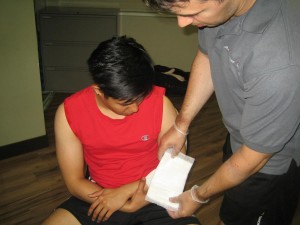Necrotic wounds are simple injuries of the skin that becomes worse by the death of the cells of the skin. This condition is caused by inadequate supply of blood and oxygen which causes the cells to become acidic and consume itself. The wounds appear as dark brown or blackish discoloration of the skin which is the area of cells that are dead.
Necrosis is the death of cells in living tissue due to external factors such as trauma, infections or toxins. Necrosis can be harmful to the health of a person and can be fatal. Necrotic tissue delays healing of a wound and there is a need to remove the affected tissue before healing can occur. Necrotic tissue is removed surgically which is a process called debridement. When large areas of the tissues become necrotic due to the lack of blood supply, it is known as gangrene.
Necrotic tissue can be a symptom of serious conditions such as skin cancer, diabetes and other skin diseases. If this infection is not properly treated, it can spread to other healthy skin cells.
Two types of necrotic tissue found in wounds
- Eschar – is the dry, thick and rubbery tissue that can be tan, black or brown in color.
- Slough – is yellow, green, tan or brown in color that appear moist, loose and stringy.

Dress the wound by wrapping it using a bandage or cover it with medical gauze.
Causes
- Poisons
- Injury
- Infections
- Inflammation
Treatment
- Maintain a moist wound to prevent dehydration and desiccation for fast healing of the area.
- Dress the wound by wrapping it using a bandage or cover it with medical gauze. Change the dressing regularly using fresh and unused gauze.
- Before covering the wound with the dressing, apply the prescribed over-the-counter wound medication to eliminate flesh-eating bacteria that makes the condition worse.
- Honey is a natural killer of the germs and sometimes more effective than antibiotics. Apply a small amount or a teaspoon over the wound before covering with gauze. Honey prevents bacteria from eating the healthy skin near the area.
- Using vinegar is good in eliminating bacteria from the affected area. In a glass filled with water, mix 1 tablespoon of vinegar and then soak the affected wound in the solution for at least 15 minutes and dress it up using gauze secured with a medical tape.
- Pour sugar on the wound to make the wound highly concentrated where bacteria cannot survive. Sugar removes dead skin in the area. Apply a teaspoon of sugar to the affected wound and cover with medical gauze. Another alternative is adding petroleum jelly on the sugar to thicken it and cover with gauze and secured using medical tape.
- Massage the area surrounding the wound to loosen up the veins and increases the flow of blood in the area.
Disclaimer
The material posted on this page for necrotic wounds is for learning purposes only. If you want to learn to properly manage necrotic wounds, register for a first aid course with a training provider near you.
